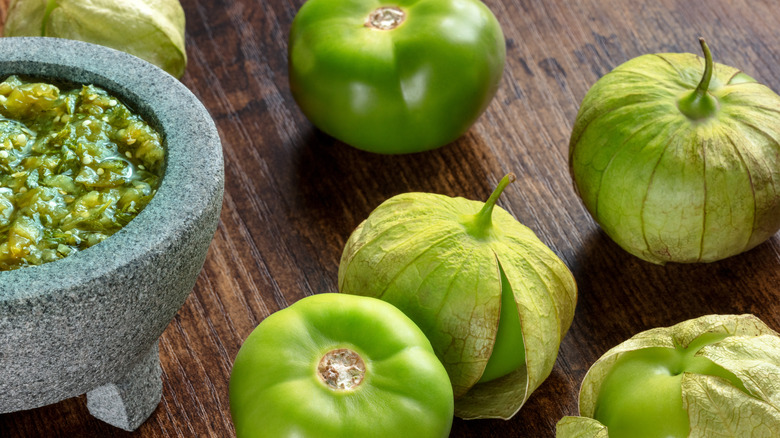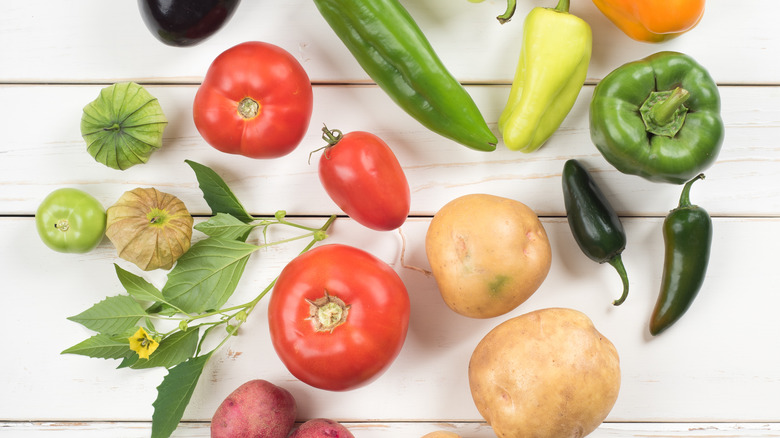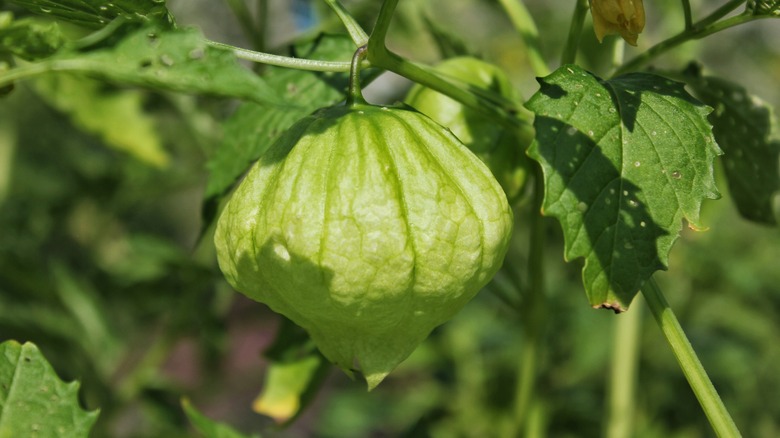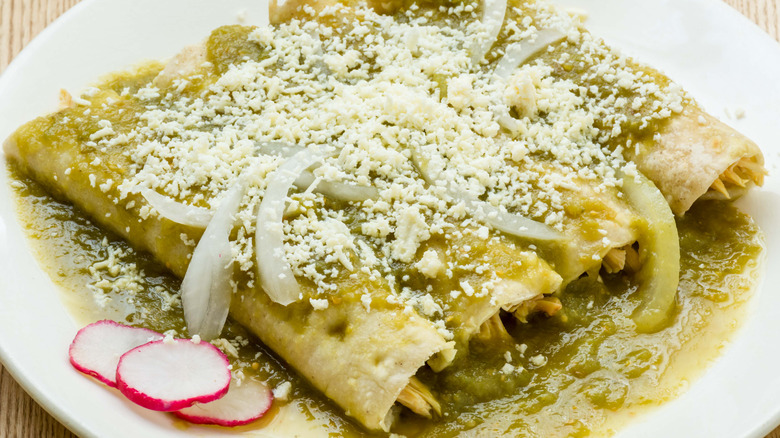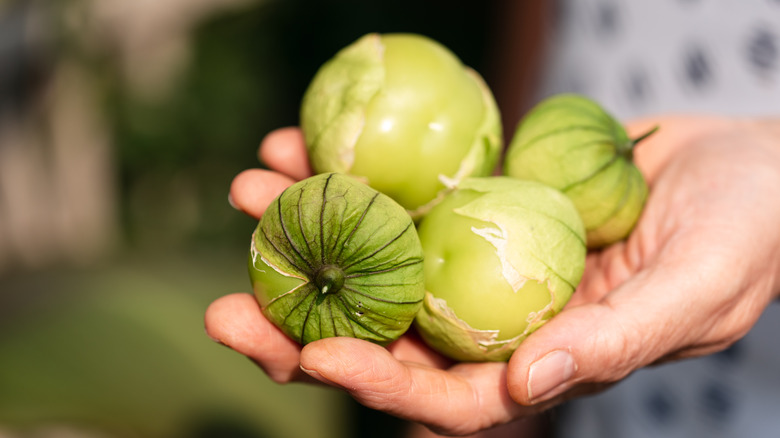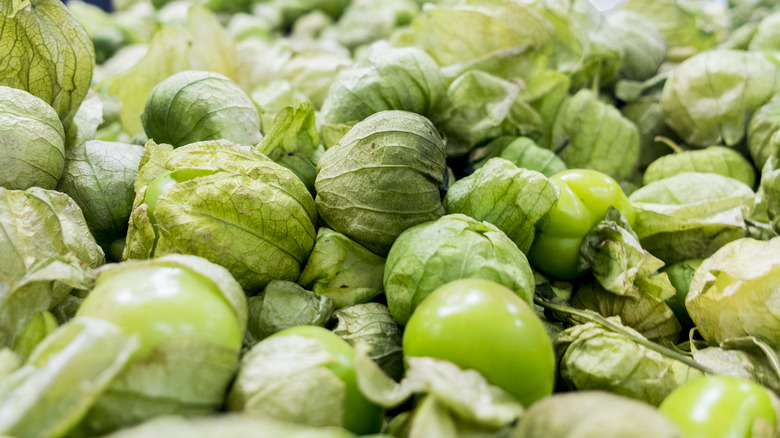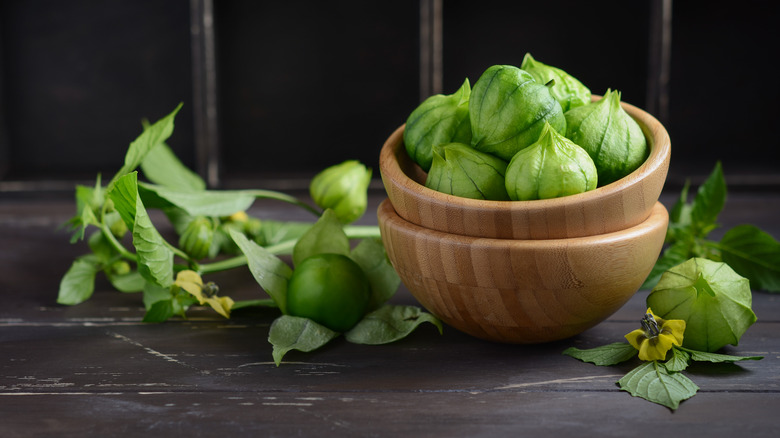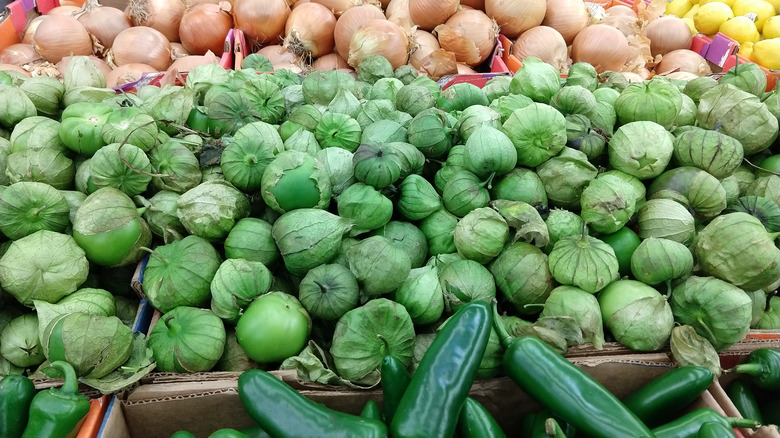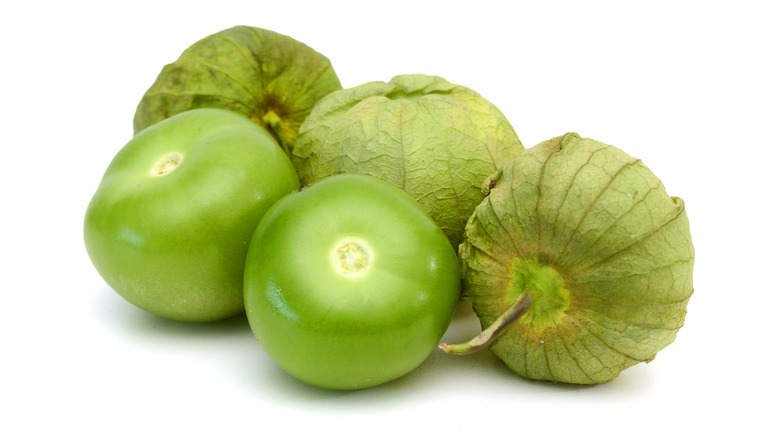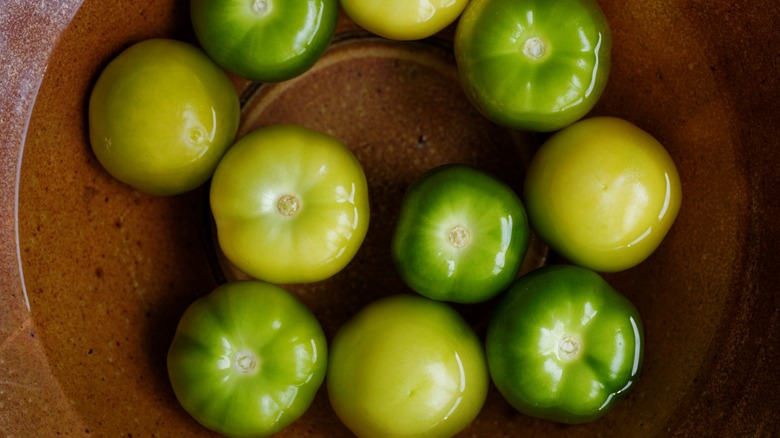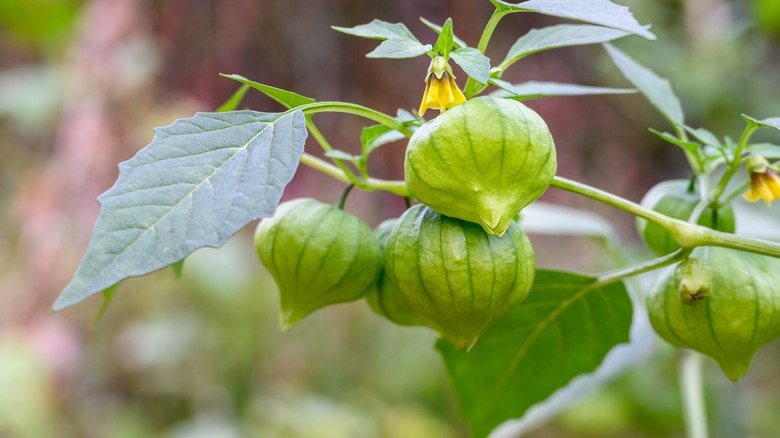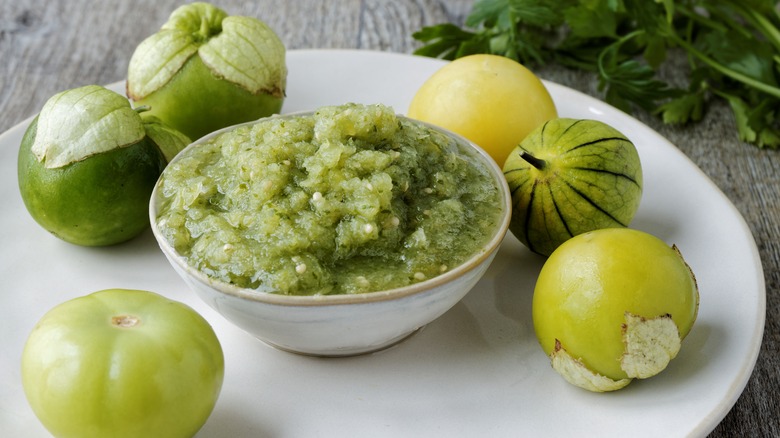Tomatillos: Everything You Need To Know
If you haven't yet been introduced to this fun-to-say fruit, here's everything you need to know about the tomatillo (aka Physalis philadelphica or Physalis ixocarpa). Let's start with the basics, which includes a common misconception. As Bon Appétit notes, no, it's not a baby tomato, although that's kind of what the name means in Spanish (tomatillo literally translates as "little tomato"). Also, it's commonly referred to as tomate verde in México, which means green tomato.
You'll sometimes hear it referred to as a husk tomato, or even a husk cherry, because of the thin, papery husk which protects the tomatillo as it grows, and must be peeled and washed before preparation (although this is sometimes done before they're displayed in supermarkets). Some even refer to it as a Mexican ground cherry, presumably due to its size and ability to self-sow (per MasterClass, ripe tomatillos that aren't harvested will drop to the ground and seed themselves).
How do tomatillos differ from related fruits like tomatoes?
Given how many other fruits tomatillos are compared to in terms of name, it's only fair to wonder how they compare in size, texture, and color. Per Small Kitchen Guide, tomatillos are both smaller and softer than green tomatoes. They're also smaller than most other varieties of tomatoes. According to MasterClass, tomatillos at their largest are about the size of a golf ball, while larger forms of tomatoes can grow as big as a softball. The one exception is cherry tomatoes. A mature tomatillo is about the same size, or slightly larger than a cherry tomato, per Harvest to Table.
Tomatoes also differ in texture from tomatillos, as MasterClass notes. Ripe tomatoes are tender, juicy, and easily bruised, whereas ripe tomatillos remain very firm and dense. What about the ground cherry, aka the cape gooseberry? Tomatillos are larger than ground cherries, but the two share the presence of a papery husk. Ground cherries are typically an orangish-yellow color, however, while tomatillos are most often green.
The history of the tomatillo
Per Scientific American, the earliest known tomatillo plant fossil was found in Patagonia and dates to 52 million years ago, making it the oldest evidence for any member of the nightshade family, which includes not just tomatoes, but also potatoes, chiles, ground cherries, and tobacco. Despite this far-flung fossil, the tomatillo's ancestral home, in terms of historical cultivation, is México, where it has been grown since at least 800 BCE, according to Many Eats. The word tomatillo, in fact, originated from the Nahuatl word tomatl, and tomatillos were important culinary ingredients for both the Aztecs and the Mayans.
It is thought that the appearance of the tomatillo in Southern Europe dates to the Spanish conquest of Mexico in the early 16th century (via Many Eats). In modern times, tomatillos grow in warm weather locales around the globe, including Australia, South Africa, and India, where they lend their distinctive flavor to curries and chutneys. They are also grown, of course, in the U.S.
Use of tomatillos in cooking
Tomatillos are most famously used in green salsas (via The New York Times) and as a staple element in Mexican cuisine. They aren't naturally spicy, but they are so often found in dishes that are spicy due to the use of chiles and chili powders, they sometimes have that reputation. Often roasted or boiled for green salsas, tomatillos themselves are typically green, although there are some varieties that are yellow-green, purple, or purple-green.
In addition to their use in green salsas, which can be served on the side or slathered generously on enchiladas and other dishes, tomatillos are used liberally throughout Mexican cuisine, per Taste of Home ... in soups, in marinades for meats, for breakfast standards like chilaquiles verdes, for signature national dishes like pozole verde, and much more.
Yes, tomatillos can be eaten raw. But they are sour, tart and acidic (per Eat Delights), as opposed to the sweeter, tangier flavor they have when cooked.
The health benefits of tomatillos
We mentioned that tomatillo is fun to say. The double l's should be pronounced like the y in yo: toe-mah-tee-yo. Beyond the euphony of the word as it rolls off your tongue, tomatillos also offer a wealth of health benefits. Per Organic Facts, they are low in sugar, fat, and carbohydrates, and rich in vitamins and minerals.
The most interesting thing about tomatillos from a health perspective, however, is that they may help reduce the risk of cancer. This is thought to be because of the presence of antioxidant phytochemicals called withanolides (via Biomedical). If that weren't enough to make you run out for a quick order of enchiladas with salsa verde, tomatillos are also reputed to improve digestion, improve vision, boost your immune system, lower blood pressure, improve heart health, and raise energy levels.
Be warned, though, that the husk, leaves, and stem of the tomatillo are toxic. Some also believe the unripe fruit is toxic, too, according to Taste of Home, and although this is somewhat controversial, it's best to steer clear of all but mature fruit.
Where to find tomatillos, and how to store them
As Our Everyday Life explains, tomatillos when ripe are easily plucked from the vine, and should be bursting from their husk, which will be turning from green to tan in color. Tomatillos are usually harvested during the late summer or early fall, per Gardening Know How.
Tomatillos are widely available in supermarkets around the U.S., according to Thrive Cuisine, including in Walmart, Whole Foods, Trader Joe's, Kroger, Publix, and Safeway stores. Fresh tomatillos should be found in the produce section, while canned tomatillos are generally found in the canned vegetable or international aisles, or with other Latin products. Fresh and canned tomatillos are available via Amazon, as are tomatillo-based salsas and sauces.
Thrive Cuisine notes that tomatillos may also be found at farmers markets, as well as at health food stores. Do not keep tomatillos next to apples and bananas, per Harvest to Table, since apples and bananas give off a natural gas called ethylene which will cause tomatillos to darken in storage.
What do tomatillos taste like?
If you take a bite of a raw tomatillo and expect it to taste like raw tomato, you're in for a surprise. Whether that's a good or bad surprise is up to the preferences of your taste buds. When uncooked, tomatillos have a distinct sour flavor that is similar to a lemon yet significantly more acerbic. The fruit can become slightly sweeter the more it ripens, but not by much. The strong, bitter taste may be overwhelming for some people.
If you're sensitive to acidity, it would be best to cook tomatillos to reduce the tartness and even add some sweetness. Placing tomatillos into the oven to roast, such as in this tomatillo salsa verde recipe, is a useful process that will help bring out the fruit's natural sugars and give you a balance of flavors. You can eat tomatillos raw or cooked, depending on if you like tangy or sweet flavors more. Just make sure you don't eat an unripe tomatillo because it will be exceedingly sour and can be toxic for you (more on that later).
What to look for when shopping for tomatillos
The average tomatillo should be bright green and covered with a green husk that bears some resemblance to the papery texture of an onion or garlic clove. If you spot tomatillos that are purple at your local grocery store, avoid purchasing. The Greater Chicago Food Depository notes that the discoloration occurs when tomatillos have over-ripened. Another sign that tomatillos are overripe is if the flesh or husk have a sticky texture. You should speak to an employee or manager if you notice mold and an unusual smell coming from tomatillos because a product in that condition should never be sold to a customer.
Although this may not be a common occurrence, make sure the flesh of the tomatillo is within the husk. Gardening Know How writes that some tomatillos grow with only an empty husk because of intense heat waves or when the plant has succumbed to a disease. The best quality tomatillos should be firm and not squishable under any circumstances. Soft tomatillos are another indicator that the fruit is too ripe.
Tomatillos versus green tomatoes
Tomatillos are often compared with green tomatoes since both fruits have somewhat similar appearances and firmness (the translation of the name doesn't help at all). Green tomatoes and tomatillos are more different from each other than either may seem. Fine Gardening notes many indicators separate the two easily.
Starting with the most noticeable difference between tomatillos and tomatoes is the flavor. Fresh tomatoes have a mild taste that can be slightly sweet or sour, depending on the type. Overall, a green tomato will resemble the flavor of a regular tomato, just with less expression. On the other hand, raw tomatillos will always have an acidic taste with more herbaceous notes.
Tomatillos and tomatoes are opposites when it comes down to texture and size as well. Slamming your hand on a tomato will either bruise it or squish it so hard that juice will squirt over your cutting board. Tomatillos will put up more of a fight as the texture stays firm for much longer than a tomato with a crisp body similar to an apple. On average, tomatillos will be much smaller than green tomatoes and more closely resemble the size of a cherry or grape tomato.
How should tomatillos be prepared?
The first step in properly preparing tomatillos is to remove the husks since that part is inedible. Thankfully, peeling the husks off is normally easy (especially if the fruit is ripe enough). Don't use a tomatillo if the husk isn't coming off, even if some of the flesh is exposed. You want to eat safely rather than be sorry after your meal. The best way to remove tougher husks is by soaking the tomatillos in warm water.
Once your food has passed the husk peeling test, you must wash the tomatillos. Excess from the husks will be left behind, which can make the tomatillos rather sticky. Continue washing each tomatillo until the surface is smooth and doesn't feel like it's going to glue to your hands.
Removing tomatillo seeds isn't mandatory, unlike the husks. You can either keep the seed within the tomatillo, or you can remove it to plant in your garden if your green thumb is itching. According to Seed Savers Exchange, a tomatillo seed can last up to six years as long as it has been stored in a chilly area without much hydration.
Are tomatillos toxic?
The fruit of tomatillos isn't poisonous (otherwise, we wouldn't eat them raw or use the ingredient when cooking). However, an unripe tomatillo is a different and more dangerous story. Whether it's ripe or not, every tomatillo contains a toxin known as solanine, which is present in many nightshade fruits like tomatoes and peppers. Bountiful Gardener notes that unripe tomatillos have higher levels of solanine, and the poison is located in the leaves and stems (remove those if still attached to the fruit).
The lantern-shaped tomatillo husk isn't actually edible either. The husk naturally dries off of the tomatillo once it's ripe enough (a good sign if you want to harvest right away). Although eating unripe tomatillos aren't life-threatening, some people can be sensitive to the toxin. Stick with eating ripe tomatillos if this sounds concerning to you.
The majority of humans are capable of handling the acidity of tomatillos. Our pets, on the other hand — not so much. Our Garden Works explains that tomatillos are especially dangerous for dogs to eat as the fruit can cause organ failure. Send your pet to the vet right away if you notice any gastrointestinal issues after potentially consuming tomatillos.
Tomatillo recipes
You can use tomatillos for a variety of dishes since the flavor can be sour or sweet depending on how the fruit has been prepared or cooked. From our creamy salsa verde recipe to other unique ones, there are plenty of ways to work tomatillos into your food.
Have you thought about giving your standard cornbread a fresh kick? If so, our green chile and tomatillo cornbread recipe is a great way to go. Cilantro, onions, and Monterey Jack cheese are other ingredients added to the mix to make this Tex-Mex version of the classic American bread. When you're done baking, the corn will appear as green as a tomatillo. If you are a spicy-food lover, you can spread pepper jelly on top for even more tanginess.
And, if you believe balanced flavors are one of the most important components in any dish, then you should try our tomatillo jam and yogurt dip recipe. The jam and yogurt fusion incorporates savory, sweet, and creamy all in one bowl. Although you can just make and spread the tomatillo jam on a piece of toast and call it a day, mixing it in yogurt will give you more balance in terms of flavor and consistency. There's even a nice blend of colors that should remind you of chili with sour cream.
